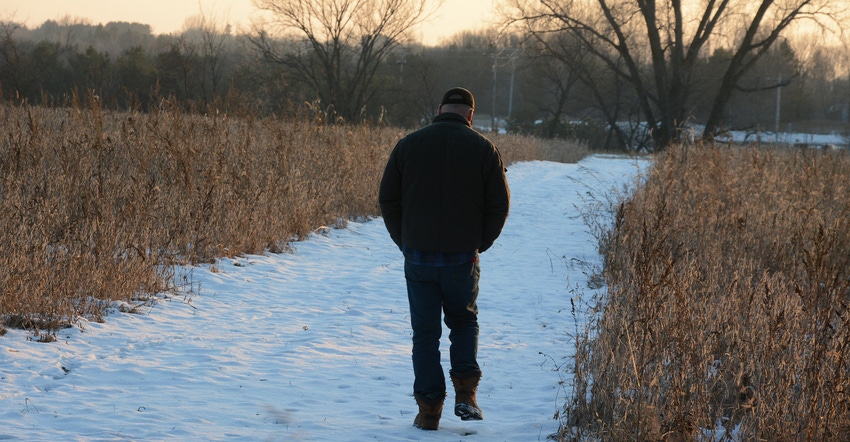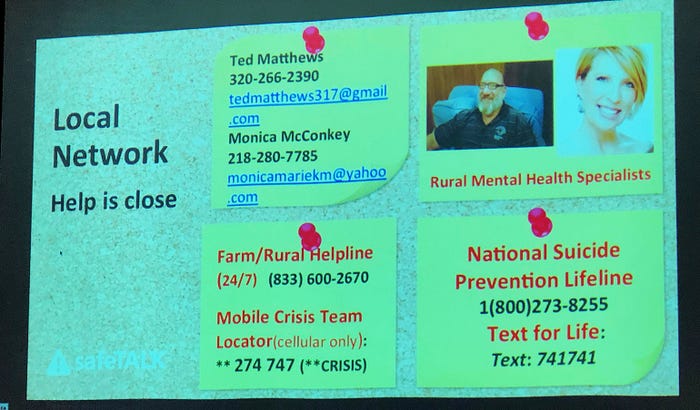
“Are you thinking about suicide?”
Oh, how tough it was to say those words, even after spending a morning in suicide awareness training.
The time had come for us to practice what we learned during safeTALK (Suicide Awareness for Everyone), a suicide alertness training program, held Dec. 4 in Waite Park and sponsored by the Minnesota Department of Agriculture and Department of Health.
SafeTALK teaches participants how to identify someone with thoughts of suicide, how to communicate and engage with them, and how to connect them with intervention resources. The training then has participants practice with each other, asking and talking about suicide.
All safeTALK sessions involving MDA were tailored for the agricultural community and taught by Glen Bloomstrom, a retired active duty chaplain with LivingWorks Education, an international suicide intervention training company. At the December session, the presentation also challenged attitudes that inhibit talk about suicide.
The start of the training session involved Bloomstrom sharing some numbers and misconceptions about suicide:
Suicide is not rare. There is one suicide attempt in the U.S. every 28 seconds.
According to 2017 data, there was one suicide every 11 minutes in the U.S.
Having thoughts of suicide is human. Whether or not someone acts on the thought determines the outcome.
Suicide is not contagious, although some reports of multiple deaths make it appear so.
You do not put the thought of suicide in someone’s mind when you ask. If someone is thinking about it, the thought is already there.
Bloomstrom explained that direct and open talk about suicide is key as he moved into training focused on TALK — Tell, Ask, Listen and Keep safe.
Often, a person contemplating suicide might tell you indirectly or directly that they are thinking about suicide, either in words or by actions. You might sense this person is desperate or has feelings of helplessness. You might see withdrawal or that they are giving away possessions. These are potential signs of suicide and the person is “telling” you about it. It’s important that you keep your eyes and ears open for that possible “invitation.”
“Virtually everyone who has suicidal thoughts has ‘told’ someone,” Bloomstrom said. When they do, that serves as an invitation for you to further open the door of communication.
At this point — and this is the uncomfortable and difficult part for many — is to simply ask the person about suicide. You could begin the conversation by saying you’d like to talk with them. You’ve noticed they seem different, that they appear to be withdrawing from family and friends, or they seem deeply stressed by farm finances. After offering your concerns, state clearly that you wonder if they are thinking about suicide.
“We need to confirm suicide is involved,” Bloomstrom said. “Words must be clear and direct, even though they are frightening to us. Do not be vague.” If you use hedging words, such as are you thinking of hurting yourself, the person may be evasive and say no.
If someone says yes, suicide is on their mind, tell them you want to talk further and listen to them. Show that you are listening with eye contact, body language, asking questions and paraphrasing what you hear to confirm that you understand.
This could be difficult for some since when we hear certain things, it’s human nature to want to fix them, Bloomstrom noted.
The final step in safeTALK is the most important and requires some work prior so you will be prepared to assist someone who is thinking of suicide. That is, keeping the person safe by connecting them with mental health and suicide prevention resources.
“Say, ‘What you are sharing is important and we need to connect with someone who can help you,’” Bloomstrom said. If the person does not want to get help, you may need to call 911. Bottom line: Do not leave the person alone and do not put yourself in danger.
Prior to talking with someone about suicide, learn about available local, state and national mental health resources. Make a list, use it and share it (see resources listed below).
Bloomstrom acknowledged how difficult it is for people to talk about suicide, let alone ask about it.
“Fear keeps us from being involved,” he said.
Yet, he encouraged people to be open to discussions and getting involved. It’s OK if you are a little nosey because you are concerned. Alcohol and child abuse were once taboo topics, too, he said. Maybe suicide someday no longer will be on that list.
 JUST A CALL AWAY: Mental health resources are available 24-7 in Minnesota. This information is available at minnesotafarmstress.com.
JUST A CALL AWAY: Mental health resources are available 24-7 in Minnesota. This information is available at minnesotafarmstress.com.

“Make the connection and take a risk,” he said. “People may refuse to go to a safe connection. We can’t strong-arm them. It’s their call. [If we don’t ask], we may lose a friend or lose a life.”
More on safeTALK
More than 200 people attended safeTALK workshops held this winter across Minnesota. Each location had waiting lists since class size was limited to 30 participants. One more seminar, scheduled for Jan. 22 in St. Cloud, is full and also has a waiting list.
MDA decided to offer the training in response to feedback regarding increasing concerns about suicide in the farming community, according to Meg Moynihan, MDA.
For more information on suicide awareness training, contact Moynihan at 651-201-6616 or email [email protected]. You can also find more information about safeTALK online.
Mental health, suicide resources
Here are some of the resources available to Minnesota farmers:
Minnesota Farm & Rural Helpline, 833-600-2670 (press 1); minnesotafarmstress.com. Free, confidential, 24-7.
Ted Matthews and Monica McConkey, rural mental health counselors: 320-266-2390 (Ted) or 218-280-7785 (Monica). There is no charge and no paperwork. Services are funded by the Minnesota Legislature.
Mobile Crisis Teams. From a cellphone, dial **CRISIS (**274-747); mn.gov/dhs/crisis. This is available in every county. Counselors can arrive quickly and provide in-person, short-term counseling or mental health services during a crisis or emergency.
National Suicide Prevention Lifeline, 800-273-8255.
University of Minnesota Extension, 800-232-9077; extension.umn.edu/rural-stress. Extension offers financial and mental health programs, news and resources, including online stress workshops.
Read more about:
Mental HealthAbout the Author(s)
You May Also Like






